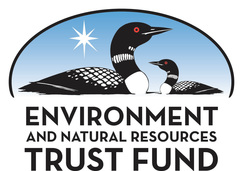What is dispersal?
While it is not obvious, plants move! In fact, plant movement (or dispersal) has two parts. First pollen moves from the father plant to the mother plant to fertilize the seeds. This is called pollen dispersal. Then seeds move from the mother plant to where they land on the ground. Here, the seeds germinate and establish. This is called seed dispersal.
What are the different types of plant dispersal?
There are two main ways in which pollen and seeds can be dispersed: either biotically (e.g., dispersed by animals), or abiotically (e.g., by wind, water, etc). Both pollen and seeds of a plant can be dispersed through these means. For example, most grasses have both pollen and seed dispersal that occurs via the wind, whereas many forbs have pollen that move by insects, but have seeds that either move by wind (like a dandelion) or by larger animals through consumption and excretion (like a cherry).
Why is prairie plant dispersal important?
Since 1908, Minnesota has lost 99% of its 18 million acres of remnant prairie. In addition to the overall loss in area, this prairie has also become broken up into increasingly smaller fragments. One way prairie ecosystems can maintain high diversity is when plant and animal species are able to disperse among fragments, ensuring their connectivity. We know very little about how far plants can move by pollen and seed, thus making the connectivity distances virtually unknown for plants. Having sufficient prairie fragment connectivity is important for maintaining key ecosystem services including increased diversity of floral resources for pollinators and other wildlife, soil stability, water quality, and plant genetic diversity - all which maintain high quality land for hunting and other recreational activities. One of the most important aspects of dispersal is the maintenance of genetic diversity, as dispersal by both pollen and seed allow for the movement of genes within fragmented prairies.
How are we trying to investigate dispersal?
We are trying to see how far pollen and seeds are actually moving. To do this, we have selected several target prairie species. We will be locating all individuals of these target species, GPS'ing their location, and sampling their DNA. In this way, we can know where parents are in relation to their offspring, and thus infer their dispersal distance.
How will our research help conserve Minnesota prairies?
Our research will give us a better idea of how far plants are able to move in order to know the necessary distance between populations in order to promote influx of new genes they need to maintain genetic diversity.
While it is not obvious, plants move! In fact, plant movement (or dispersal) has two parts. First pollen moves from the father plant to the mother plant to fertilize the seeds. This is called pollen dispersal. Then seeds move from the mother plant to where they land on the ground. Here, the seeds germinate and establish. This is called seed dispersal.
What are the different types of plant dispersal?
There are two main ways in which pollen and seeds can be dispersed: either biotically (e.g., dispersed by animals), or abiotically (e.g., by wind, water, etc). Both pollen and seeds of a plant can be dispersed through these means. For example, most grasses have both pollen and seed dispersal that occurs via the wind, whereas many forbs have pollen that move by insects, but have seeds that either move by wind (like a dandelion) or by larger animals through consumption and excretion (like a cherry).
Why is prairie plant dispersal important?
Since 1908, Minnesota has lost 99% of its 18 million acres of remnant prairie. In addition to the overall loss in area, this prairie has also become broken up into increasingly smaller fragments. One way prairie ecosystems can maintain high diversity is when plant and animal species are able to disperse among fragments, ensuring their connectivity. We know very little about how far plants can move by pollen and seed, thus making the connectivity distances virtually unknown for plants. Having sufficient prairie fragment connectivity is important for maintaining key ecosystem services including increased diversity of floral resources for pollinators and other wildlife, soil stability, water quality, and plant genetic diversity - all which maintain high quality land for hunting and other recreational activities. One of the most important aspects of dispersal is the maintenance of genetic diversity, as dispersal by both pollen and seed allow for the movement of genes within fragmented prairies.
How are we trying to investigate dispersal?
We are trying to see how far pollen and seeds are actually moving. To do this, we have selected several target prairie species. We will be locating all individuals of these target species, GPS'ing their location, and sampling their DNA. In this way, we can know where parents are in relation to their offspring, and thus infer their dispersal distance.
How will our research help conserve Minnesota prairies?
Our research will give us a better idea of how far plants are able to move in order to know the necessary distance between populations in order to promote influx of new genes they need to maintain genetic diversity.

